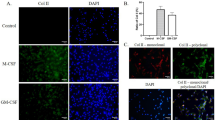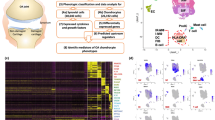Abstract
Articular chondrocytes from nine arthritic patients, five infants, and Balb/c neonatal mice were analyzed for the presence of various cytokine mRNAs by a reverse transcriptase polymerase chain reaction (RT-PCR). Four cytokine mRNAs, interleukin (IL)-6, IL-8, IL-11, and macrophage colony stimulating factor (M-CSF), were detected in all human chondrocytes, regardless of source. IL-10, IL-12p35, and tumor necrosis factor alpha (TNF-α) transcripts were found in at least 12 of the 14 human samples. IL-13, granulocyte colony stimulating factor (G-CSF), granulocyte macrophage colony stimulating factor (GMCSF), and TNF-βmRNAs were found more predominantly in infant samples and in samples from patients with rheumatoid arthritis (RA) compared with samples from patients with osteoarthritis (OA). Another group of cytokine mRNAs, IL-1 (α, β), IL-4, IL-5, and IL-7, were only weakly expressed in some human samples. The cytokine transcripts that were not found were IL-2, IL-3, and interferon gamma (IFN-γ. Because of the large array of cytokine transcripts detected, human chondrocyte preparations were further purified by reacting them with a monoclonal antibody specific to chondrocyte differentiation antigen and subjecting them to fluorescent-activated cell sorting. A similar array of cytokines was found between the sorted and unsorted chondrocytes, although TNF-α, G-CSF, and GM-CSF transcripts appeared to be upregulated during the sorting process. Human chondrocytes that dedifferentiated into fibroblasts (a 40-day and a 77-day culture) no longer expressed mRNAs for IL-1, G-CSF, GM-CSF, and TNF-α, but all other cytokine mRNAs remained detectable. Although certain phenotypic characteristics were lost:, including reactivity to chondrocyte-specific monoclonal antibodies and morphological features, chondrocytes in long-term culture still expressed cytokine mRNAs. As expected, more consistent results were obtained when seven preparations of chondrocytes from neonatal Balb/c mice were examined using available cytokine primers. They contained IL-1, IL-5, IL-6, IL-7, IL-12, GM-CSF, M-CSF, transforming growth factor beta (TGF-β), TNF-α, and TNF-β mRNAs but lacked IL-2, IL-3, IL-4, IL-10, and IFN-γ mRNAs. Future experiments to define conditions by which these cytokine protein products are expressed are needed to help assess their roles in chondrocyte biology and in disease states.
Similar content being viewed by others
References
Malemud CJ (1993) The role of growth factors in cartilage metabolism. Rheum Dis Clin North Am 19:569–580
Guerne PA, Sublet A, Lotz M (1994) Growth factor responsiveness of human articular chondrocytes: distinct profiles in primary chondrocytes, subcultured chondrocytes, and fibroblasts. J Cell Physiol 158:476–484
Mohamed AH (1995) Influence of interleukin-1β, tumour necrosis factor a and prostaglandin E z on chondrogenesis and cartilage matrix breakdown in vitro. Rheumatol Int 14:191–199
Ollivierre F, Gubler U, Towle CA, Laurencin C, Tredwell BV (1986) Expression of IL-1 genes in human and bovine chondrocytes: a mechanism for autocrine control of cartilage matrix degradation. Biochem Biophys Res Commun 141:904–911
Guerne P, Carson DA, Lotz M (1990) IL-6 production by human articular chondrocytes: Modulation of its synthesis by cytokines, growth factors, and hormones in vitro. J Immunol 144:499–505
Lotz M, Terkeltaub R, Villiger P (1992) Cartilage, and joint inflammation regulation of IL-8 expression by human articular chondrocytes. J Immunol 148:466–473
Maier R, Gann V, Lotz M (1993) Interleukin-11, an inducible cytokine in human articular chondrocytes and s noviocytes, stimulates the production of the tissue inhibitor ofmetalloproteinases. J Biol Chem 268:21527–21532
Campbell IK, Novak U, Cebon J, Layton JE, Hamilton JA (1991) Human articular cartilage and chondrocytes produce hemopoietic colony-stimulating factors in culture in response to IL-1. J Immunol 147:1238–1246
Seid JM, Rhamim S, Gravely R, Bunning RA, Nordmarm R, Wishart W, Russel RG (1993) The effect of interleukin-1 on cytokine gene expression in cultured human articular chondrocytes analyzed by messenger RNA phenotyping. Arthritis Rheum 36:35–43
Alsalameh S, Firestein GS, Oez S, Kurrle R, Kalden JR, Burmester GR (1994) Regulation of granulocyte macrophage colony stimulating factor production by human articular chondrocytes. Induction by both tumor necrosis factor-α and interleukin 1, downregulation by transforming growth factorβ and upregulation by fibroblast growth factor. J Rheumatol 21:993–1002
Campbell IK, Ianches G, Hamilton JA (1993) Production of macrophage colony-stimulating factor (M-CSF) by human articular cartilage and chondrocytes. Modulation by interleukin-1 and tumor necrosis factor-α. Biochim Biophys Acta 1182:57–63
Abbott J, Holtzer H (1966) The loss of phenotypic traits by differentiated cells. J Cell Biol 28:473–487
Chacko S, Abbott J, Holtzer S, Holtzer H (1969) The loss of phenotypic traits by differentiated cell. J Exp Med 134:417–442
Benya PD, Shaffer JD (1982) Dedifferentiated chondrocytes reexpress the differentiated collagen phenotype. Cell 30:215–224
Arnett FC, Edworthy SM, Bloch DA, McShane DJ, Fries IF, Cooper NS, Healey LA, Kaplan SR, Liang MH, Luthr HS, Medsger TA Jr, Mitchell DM, Neustadt DH, Pinals RS, Schaller JG, Sharp IT, Wilder RL, Hunder GG (1988) The American Rheumatism Association 1987 revised criteria for the classification of rheumatoid arthritis. Arthritis Rheum 31:315–324
Kimura LH, Plymyer M, McLean L, Yamaga KM, Lance EM (1991) Reaction of antibody to mycobacterial 65 kd heat-shock protein with human chondrocytes. J Autoimmun 4:881–892
Yokoyama WM (1991) Cryopreservation of cells. In: Coligan JE, Kruisbeek AM, Margulies DH, Shevach EM, Strober W (eds) Current protocols in immunology. Wiley, New York, pp A3.15-A3.17
Sambrook J, Fritsch EF, Maniatis T (1989) Molecular cloning: a laboratory manual, 2nd edn. Cold Spring Harbor Laboratory Press, Plainview, NY, pp 6.24–6.27
Yamaga KM, Kimura LH, Plymyer MR, Glant TT, Lance EM (1994) Differentiation antigens of human articular chondrocytes and their tissue distribution as assessed by monoclonal antibodies. J Autoimmun 7:203–217
Tanabe B (1994) Cytokine repertoire of human articular chondrocytes in relationship to culture conditions and dedifferentiation. MS thesis, University of Hawaii
Recklies AD, Golds EE (1992) Induction of synthesis and release of interleukin 8 from human articular chondrocytes and cartilage explants. Arthritis Rheum 35:1510–1519
Malfait AM, Verbruggen G, Veys EM, Lambert J, De Ridder L, Cornelissen M (1994) Comparative and combined effects of interleukin 6, interleukin 1β, and tumor necrosis factor-α on pro teoglycan metabolism of human articular chondrocytes cultured in agarose. J Rheumatol 21:314–320
Schadendorf D, Moller A, Algermissen B, Worm M, Sticherling M, Czarnetzki BM (1993) IL-8 produced by human malignant melanoma cells in vitro is an essential autocrine growth factor. J Immunol 151:2667–2675
Fuller K, Owens JM, Jagger CJ, Wilson A, Moss R, Chambers TJ (1993) Macrophage colony-stimulating factor stimulates survival and chemotactic behavior in isolated osteoclasts. J Exp Med 178:1733–1744
Thomson AW (1994) The cytokine handbook, 2nd edn. Academic Press, San Diego, Calif.
Del Prete G, De Carli M, Almerigogna F, Giudizi MG, Biagiotti R, Romagnani S (1993) Human IL-10 is produced by both type 1 helper (Th 1) and type 2 helper (Th 2) T cell clones and inhib its their antigen-specific proliferation and cytokine production. J Immunol 150:353–360
Trichieri G (1975) Interleukin 12: a proinflammatory cytokine with immunoregulatory functions that bridge innate resistance and antigen-specific adaptive immunity. Ann Rev Immunol 13:251–256
Minty A, Chalon P, Derocq JM, Dumont X, Guillemont JC, Kahad M, Labit C, Leplatois P, Liauzun P, Miloux B, Minty C, Casellas P, Laison G, Lupber J, Dhire D, Ferrara P, Caput D (1993) Interleukin 13 is a new human lymphokine regulating inflammatory and immune responses. Nature 362:248–250
Zurawski G, de Vries JE (1994) Interleukin 13, an interleukin 4-like cytokine that acts on monocytes and B cells, but not on T cells. Immunol Today 15:19–26
Author information
Authors and Affiliations
Additional information
Supported, in part, by Shriners Hospitals for Crippled Children (project no. 15955) and the E. M. Lance Research Fund. Some of the data were presented in a thesis as partial fulfillment of the Master's of Science Degree at the University of Hawaii for B. K. T.
Rights and permissions
About this article
Cite this article
Tanabe, B.K., Abe, L.M., Kimura, L.H. et al. Cytokine mRNA repertoire of articular chondrocytes from arthritic patients, infants, and neonatal mice. Rheumatol Int 16, 67–76 (1996). https://doi.org/10.1007/BF01816438
Received:
Accepted:
Issue Date:
DOI: https://doi.org/10.1007/BF01816438




